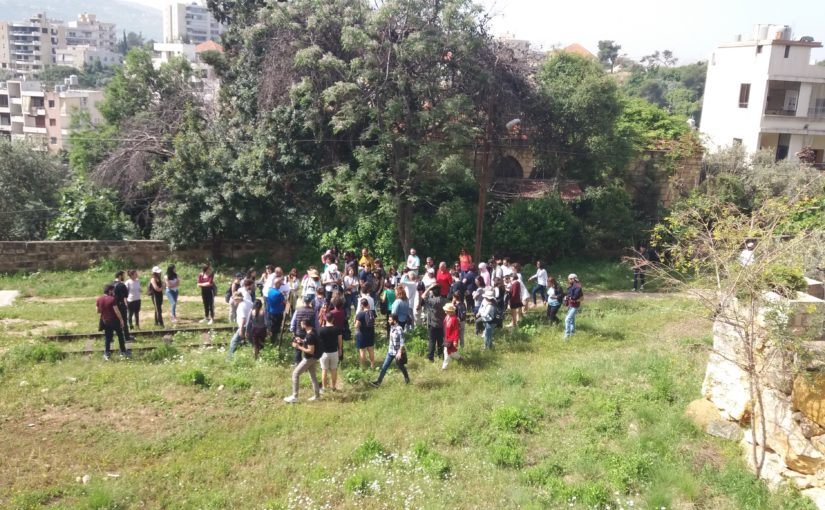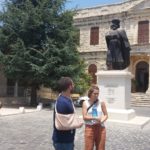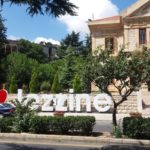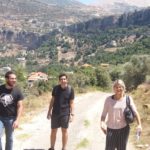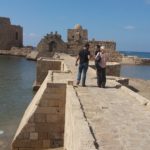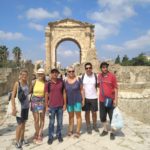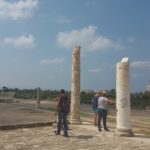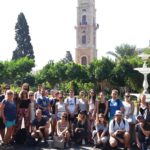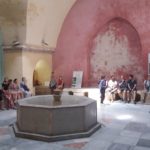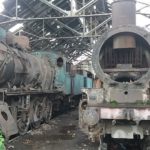by Chadi Faraj and Jad Baaklini
في 1 ايار عيد العمال وبعد اكثر من 120 سنة على انطلاق اولى رحلات القطار من جسر الحديد في مار مخايل نظمت جمعية تران تران لبنان و جمعية حقوق الركاب (Bus Map Project) رحلة جديدة على نفس مسار قطار بيروت رياق , فأنطلقت 4 باصات عاملة حاليا على احد خطوط النقل المشترك في التاسعة والنصف صباحا لاعادة استكشاف مسار هذا القطار واعادة ضخ بعض الحياة في مقطوراته ومقصوراته ومحطاته المنسية والمهملة المخفيه بين ثنايا طرقاته وتلاله وبعض التعديات على املاك السكة التي حاولت ان تطمس معالمه وتكتم صوته الصادح. فوق هذا الجسر الحديدي… بدأنا بالتجمع وانتظار الجميع للوصول وبدأ التعرف على بعض من التاريخ المنسي والمهمل.
٤ سائقين يعملون على خط النقل المشترك دورة بعبدا تكفلوا بمرافقتنا ابو زهرا- وليد- فادي – ابو حنا، نساء رجال واطفال حوالي ١٢٠ شخص انطلقنا نحو أول المحطات، محطة بعبدا حيث تعرفنا وشاهدنا السكك التي يستعملها القطار لصعود المرتفعات والتي صممت خصيصا لهذا المسار واستلم كل من أيدي والياس وكارلوس التعريف عن المسارات وتاريخ كل المحطات والنقل السككي. وزعنا الخريطة على الحاضرين ولفتنا الى اهمية النقل المشترك في لبنان وبعض المشاكل التي يعاني منها واهمية كسر بعض الافكار المسبقة عن القطاع الشعبي الموجود وخصوصا اليوم اننا قد استقلينا عينة صغيرة من الباصات العاملة على احدى الخطوط.
محطة الجمهور هي بجانب الاوتستراد طريق الشام وهناك التقينا المعلم ايليا وهو احد سائقي القطار في عز مجده وقد حدثنا عن تجربته والكثير من الاحداث والشخصيات التي عاصرها هو والقطار.
الى محطة عاريا المخبأة داخل البلدة واشجارها المعمرة والتي تلفظ روائح الماضي ومن ثم مرورا بمحطة بحمدون الى محطة صوفر و اوتيل صوفر الكبير الذي كان له دور كبير في استقبال كبار الشخصيات والعائلات للاصطياف من اقصاع الارض عبر استقلال خط بيروت الشام.
واخيراً وليس اخرا محطة رياق البلدة او المدينة التي كانت نقطة مهمة في وصل لبنان بخط دمشق واهميتها الكبرى على ما كنت تحتويه من مشاغل ومصانع لقطع القطارات وعن خبرات العمال واكتشفاتهم واختراعاتهم في بعض تكنولوجيا القطار في ذلك العصر الجميل. فعند وصولك الى رياق ترى اعداد القطارات والفاكونات والقطع والاقسام والتاريخ الذي يرسم على وجه كل مشارك فيتساءل الجميع اين نحن من هذا الزمن اقله لماذا لا يوجد متحف على الاقل يحتوي على جميع هذه التحف؟ او تساءل اخر لماذا لا يعود القطار على السكة بعد كل هذا التاريخ.
ان مشوار عالسكة ليس اولى الرحلات التي قمنا بها كمشروع ولكن دون شك انه من انجحها… وخصوصا اننا تشاركنا بتنظيمها مع جمعية تران تران.
لماذا المشوار ب الباص؟!
بدأنا بها ما يقارب السنتين برحلات صغيرة لعدد من المناطق اللبنانية مستخدمين خطوط النقل المشترك من اجل تعريف على الخطوط وكذلك تجميع المعلومات عنها وكسر بعض الافكار المسبقة عن القطاع والمناطق واننا نستطيع اكتشاف لبنان بالنقل المشترك اظهار وجود ترابط جيد بين جميع المناطق .
لقد زرنا بعقلين وحرشها والضيعة والمكتبة العامة واكتشفنا سويا بيت الدين ودير القمر بأستعمال احد خطوط الباصات الى الجبل من الكولا في احد الاحاد في ال2017.
زرنا صيدا اكثر من مرة مع اكثر من مجموعات صغيرة حيث تعرفنا على احياء صيدا القديمة وقلعتها البحرية والبرية وخان الصابون واكلنا اطيب الفلافل والسيندويشات في اسواقها دون ان ننسى الكنافة. ومن صيدا استقلينا خط صيدا جزين واسكشفنا جزين سويا من شلالها الى بعض معالهما وتمشينا بين احراشها واحراش بكاسين .
توجهنا في نهاية الاسبوع من الصيف الماضي الى صور وبحرها وقلعتها البحرية التي صدت اسكندر المقدوني الكبير التي بنيت على شبه جزيرة ومشينا في اسواقها القديمة والجديدة ومررنا ب مرفئها وزرنا قلعتها البرية التي تحوي على اكبر ميدان لسباق الخيل وتسبحنا في بحرها وقضينا نهار طويل على شاطئها .
ام مدينة طرابلس فلها الحصة الاكبر من زياراتنا فقد رافقنا وترافقنا في العديد من الرحلات الى المدينة الجميلة بأهلها وتواضعها مدينة الفقراء والاحياء الحية والمفعة بالحياة فقد زرنا جميع اسواقها وجوامعها وكنائسها وقلعتها الشهيرة ومينائها الجميل ومجطة القطار القديمة التي تنتظر احياءها .
واريد ان اشكر كل من رافقنا في جميع الرحلات او تطوع معنا وعرفنا على منطقته واعطانا من خبرته ووقته.
فأن كنت مهتم بمشاركتنا المشاوير اللاحقة او ان كنت تريد ان تكون مرشدنا السياحي أيضا في منطقتك او منطقة تعرفها انضم الى مجموعة واتساب
https://chat.whatsapp.com/GOb9SAGERgj7zolXjeI1fY
On May 1st, or International Workers’ Day, and after 120 years after the very first train to roll out from Jisr Al-Jadeed to Mar Mikhael, Riders’ Rights Lebanon (Bus Map Project) and Train/Train teamed up to organize a trip along this very same route — the old Beirut to Riyak railway line — through Lebanon’s existing public transport. Four buses took off at 9:30 AM, making a seemingly commute into a time of discovery, as we traced the old locomotive Right of Way and breathed life back into its neglected signs, stocks and stations, now forgotten and obscured among the hills and interstices of modern infrastructure — including those encroachments on railway property that attempt to cover up and silence the railway’s memory. On that iron bridge… we gathered and recalled forgotten history.
Four bus drivers who work along the Dora – Baabda bus line agreed to accompany us on this journey: Abou Zahra, Walid, Fadi and Abou Hanna. We were around 120 people in total — men, women, and children. Our first stop was the old Baabda Train Station, where we learned about the special tracks created especially for this line and journey, which is an elevated path. Train/Train’s Eddy, Elias and Carlos took turns to introduce us to different moments of Lebanon’s rail history, discerning the different routes in the old network. We distributed our bus and van map to all attendees and underscored the importance of public transport in Lebanon, highlighting some of the challenges the sector faces; we especially focused on the need to break some of the stigmas and preconceptions that people hold about Lebanon’s existing transit system, as people experienced a small taste of it that day.
Next, we went to the Joumhour Train Station, which is alongside the Damascus Highway; there, we let ma’alem Elliah, a former train driver during the golden age of rail; he shared with us his experiences, telling us about some of the incidents and personalities he encountered during his tenure on the tracks.
Afterwards, we went to Arayya Train Station that’s tucked away among the trees in town, with scents of the past wafting all around; then, to Sawfar Station via Bhamdoun. Sawfar Hotel played a huge role in the rail system, as it hosted large numbers of summer travelers and celebrities from all over the world, who flocked to the area via the Damascus-Beirut railway line.
Finally, we arrived at Riyak Station. The city of Riyak was an important industrial hub that connected Lebanon to the Syrian hinterlands; it also contained factories for building and dismantling trains. Riyak was a place where great innovations in local railway technologies were developed in the heyday of train travel. As soon as we arrived, you were struck by the number of engines and wagons and bits of rail history littering the area; the emotional impact of this landscape could be seen on the faces of every one of us. We marveled at how far we’ve drifted from this era of connectivity — we wonder why there isn’t, at there very least, a museum for these national treasures? Some also wondered why there aren’t any trains back on the tracks after all these years.
This journey along the tracks isn’t the first trip we’ve organized as a project, but it definitely was one of the most successful, thanks to our partnership with Train/Train. But why did we choose to go by bus?!
Over the past few years, we’ve been organizing small excursions to different regions of the country, introducing people to the public transport system in Lebanon. We did this to gather data and stories about the bus routes, but also, to challenge preconceptions about the transit sector and the regions it stitches together. Despite everything, there is still good connectivity across Lebanon.
We’ve visited Baakline — its Horsh, main town and public library — and explored Beiteddine and Deir el Qamar riding one of the many bus lines to Mount Lebanon from Cola, on different Sundays in 2017. We also visited Saida many times, with many small groups, where we explored the old districts, the sea fortress and traditional soap markets, and had the best falafels and kanafeh. And from Saida, we took a bus to Jezzine, where we visited its famous waterfall and other landmarks, as well as strolling through its forests and the green spaces of Bkassine.
Last summer, we also went to Tyre, where we enjoyed its old and new markets, its ancient hippodrome, and island-like sea fortress, that stood up against Alexander the Great; we swam by its shores and spent a wonderful time on its beaches. Tripoli got the lion’s share of our visits, as we accompanied many groups on excursions to this beautiful city, full of life and vibrancy, through its kind and modest people. We visited all its markets, mosques and churches, as well as its famous castle and port (Mina) — as well as, of course, its old railway station.
I want to thank everyone who joined us on these trips, and all who volunteered their time and expertise to help us discover their regions. If you would like to participate in a trip, or if would like to play the role of our tour guide in your part of the country, join our WhatsApp group.
